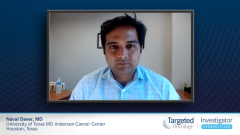
Treatment Options for Low-Risk Myelodysplastic Syndrome
Naval Daver, MD, illustrates the goals of treatment and treatment options for low-risk myelodysplastic syndrome.
Episodes in this series
Naval Daver, MD: For low-risk
The goal of treatment of low-risk MDS is really to reset the bone marrow by removing or reducing the dysplastic changes as much as possible and stimulating the production of normal red cells, platelets, and white [blood] cells. The treatments are usually a very low intensity therapy because we’re not really trying to kill large amounts of leukemia or cancer cells here, but it’s really more treatment to reset the bone marrow. For patients who have low hemoglobin, we often will check the erythropoietin level.
Erythropoietin is a hormone that helps stimulate hemoglobin; if the erythropoietin level is less than 500 [mU/mL], we can often use growth factors called erythropoietin-stimulating agents. Drugs like Procrit [epoetin alfa], Aranesp [darbepoetin alfa], and others can help bring the hemoglobin up in about 50% to 60% of patients and make them transfusion independent. Usually this could last for 1 to 4 years. Now there are also new drugs, such as luspatercept, that work through unique ways to stimulate production of hemoglobin; they seem to work even in patients who have failed erythropoietin-stimulating agents. These have been recently approved and are available. For patients who predominantly have problems with low white [blood cell] count and low neutrophils, putting them at a high risk of infection, then using growth factors that stimulate white cells, such as Neupogen [filgrastim] and Neulasta [pegfilgrastim], could be considered.
Then we have a big group of low-risk MDS that has hypoplastic or aplastic changes; they have low cells in the bone marrow to begin with, and we are trying to stimulate the overall bone marrow to have more cells and produce more hemoglobin, platelets, white cells. For this hypoplastic/aplastic MDS sort of scenario, we can use immunosuppressive therapy like cyclosporine, cyclosporine/ATG [antithymocyte globulin], cyclosporine/ATG/steroids; they seem to work quite well.
There is also a third type of unique low-risk MDS called MDS associated with deletion 5q. In some cases, this is an isolated deletion 5q chromosome abnormality, in some cases it’s a deletion 5q with other abnormalities. These patients seem to respond very well to an oral therapy called lenalidomide or Revlimid. Especially in the isolated deletion 5q, their complete hematologic response rate to lenalidomide is almost 65% or 70%; it’s not as high with those who have deletion 5q with other associated abnormalities, about 35%, 40%. Therefore, we would consider the use of lenalidomide in patients with a known deletion 5q.
Now transplant is very tricky especially in low-risk MDS. Bone marrow transplant, also called allogeneic stem cell transplant, is really the only curative option for MDS and in AML, both in low risk and high risk. However, this procedure is a very major procedure. It does have a high risk of complications, including acute and chronic graft-versus-host disease [GvHD], and potential mortality from post-transplant infections and severe forms of the GvHD. We almost never will transplant lower-risk MDS because these patients can have a median survival anywhere from 5 to 10 years; often these are older patients, 65 or 70 years old, so exposing them to transplant may actually cause more damage and more harm than benefit.
We are now learning that even those patients who are at lower risk due to having lower blasts and not as severe cytopenias, may still have mutations like TP53, EZH, and RUNX1, that could actually put them at a higher predictive risk of transformation. Now we are restructuring the MDS risk scoring, and soon we will be seeing an MDS IPSS scoring system that incorporates molecular information. This may move some of the patients with traditional lower-risk MDS to higher risk just based on the presence of their mutations.
Transcript edited for clarity.









































